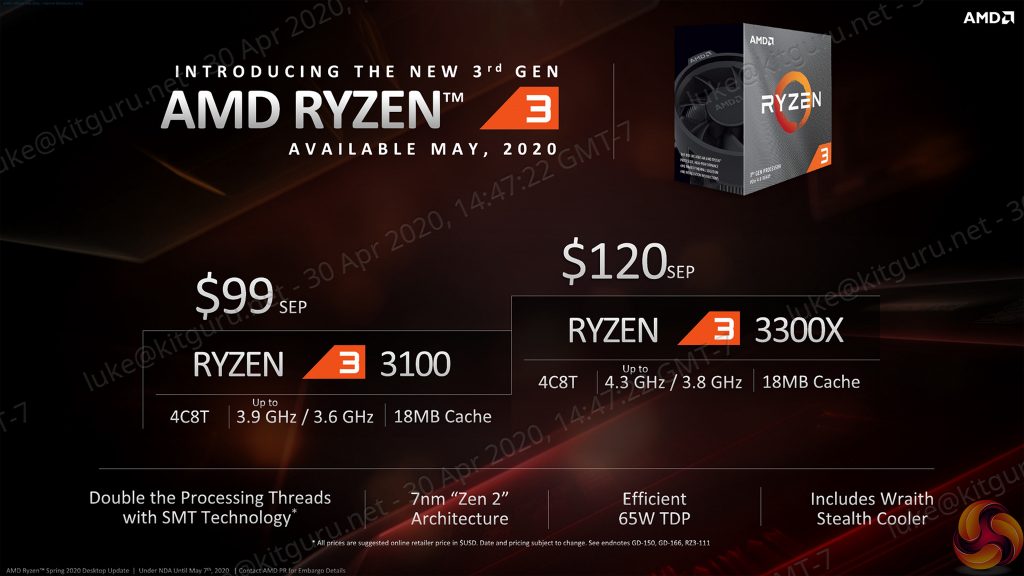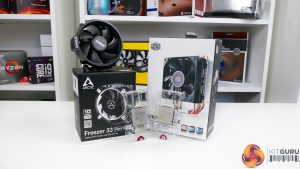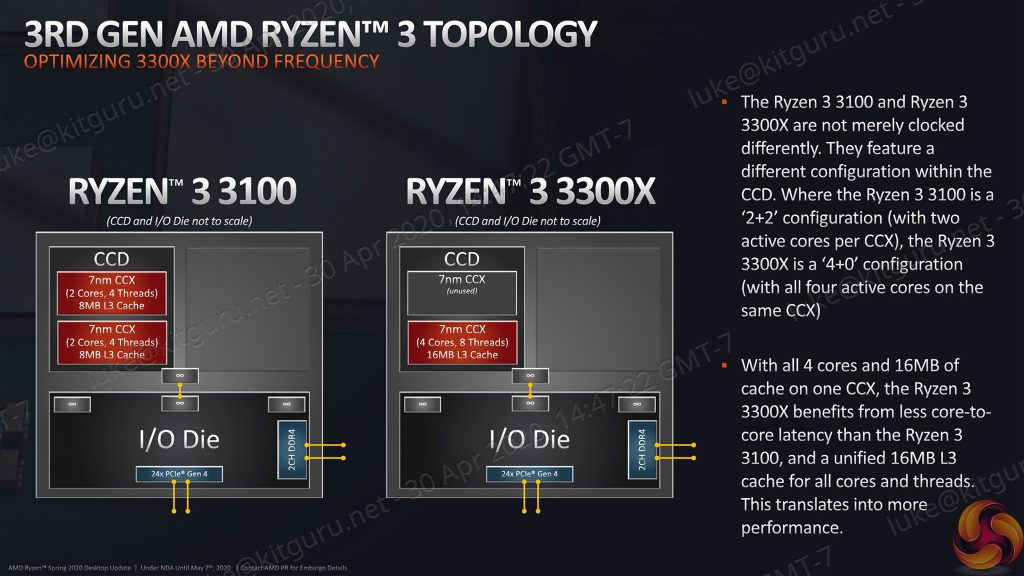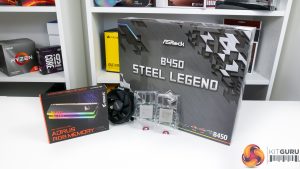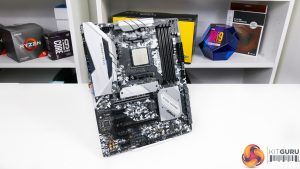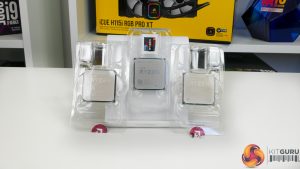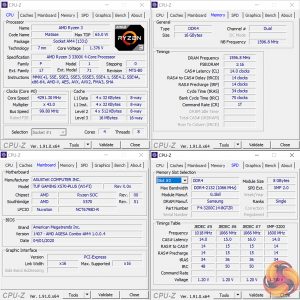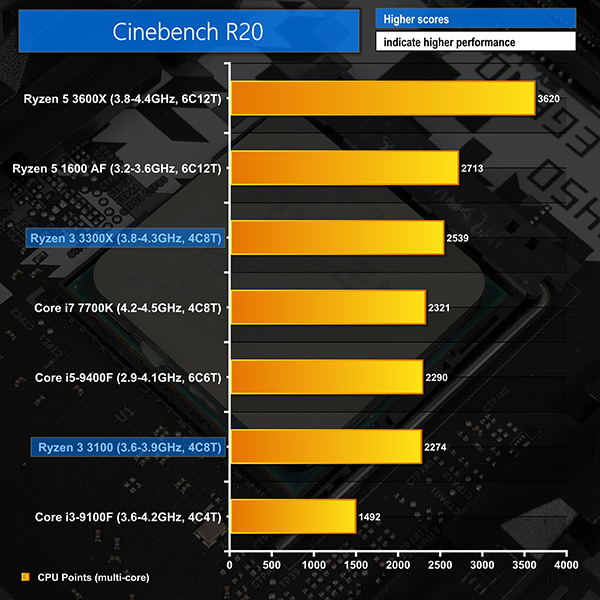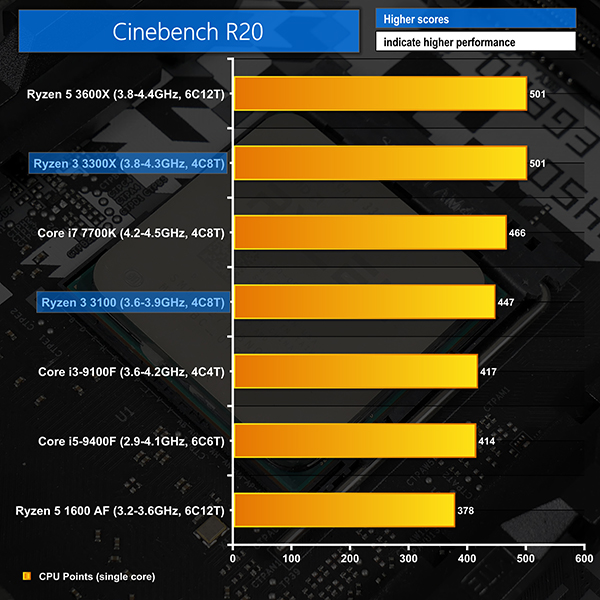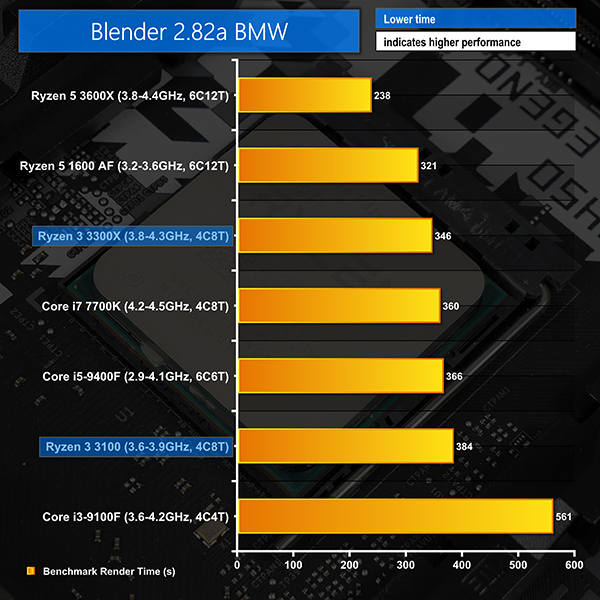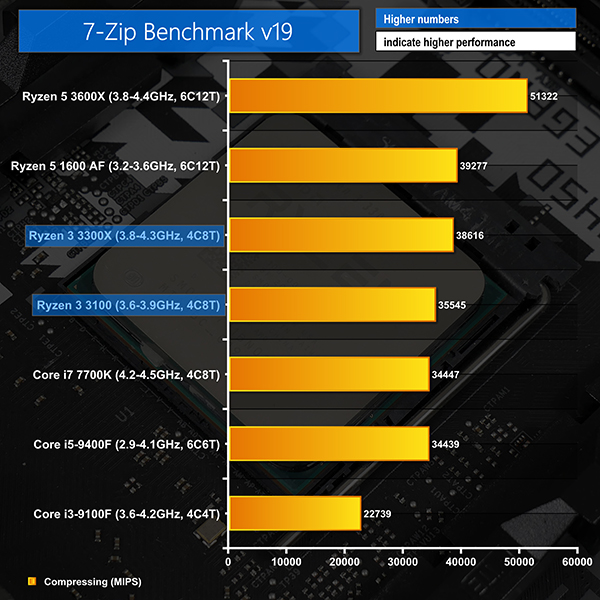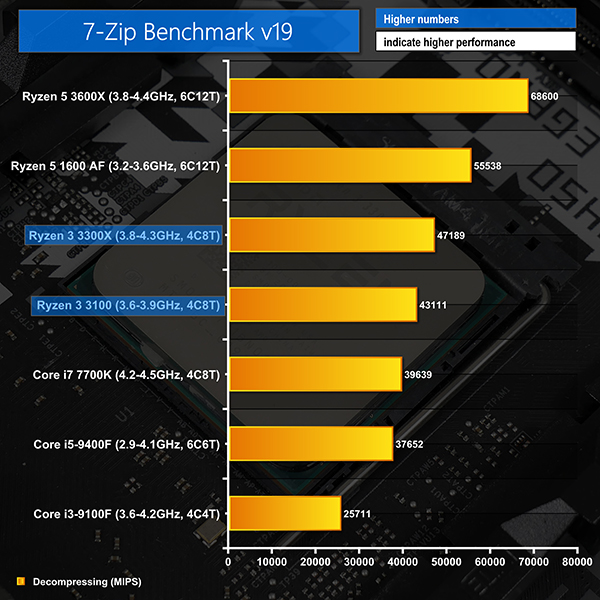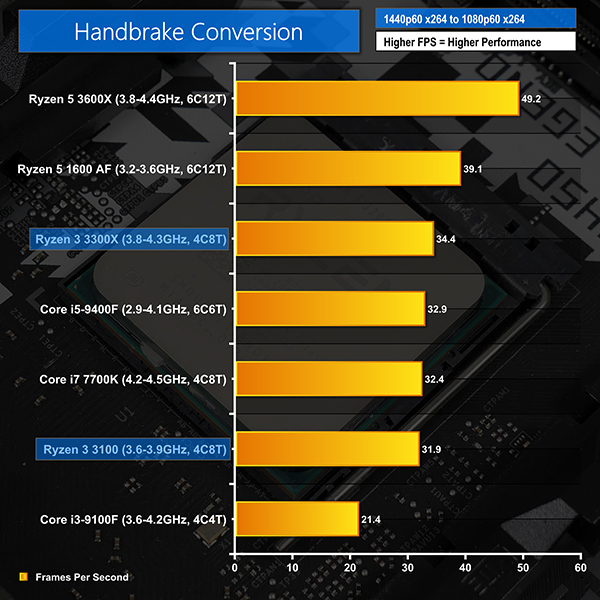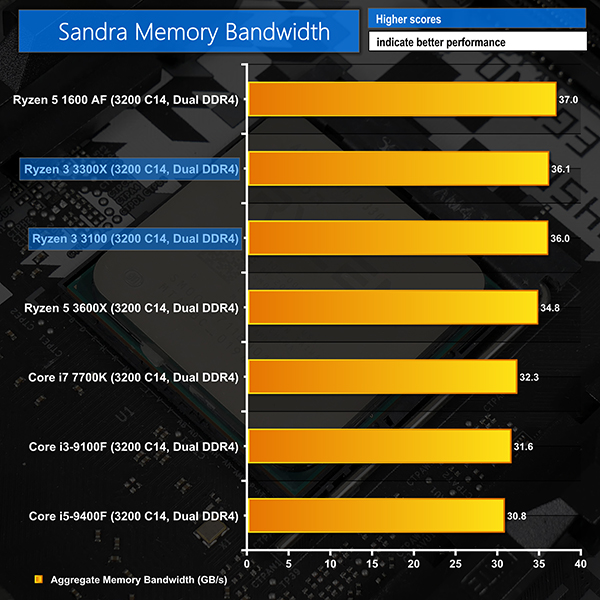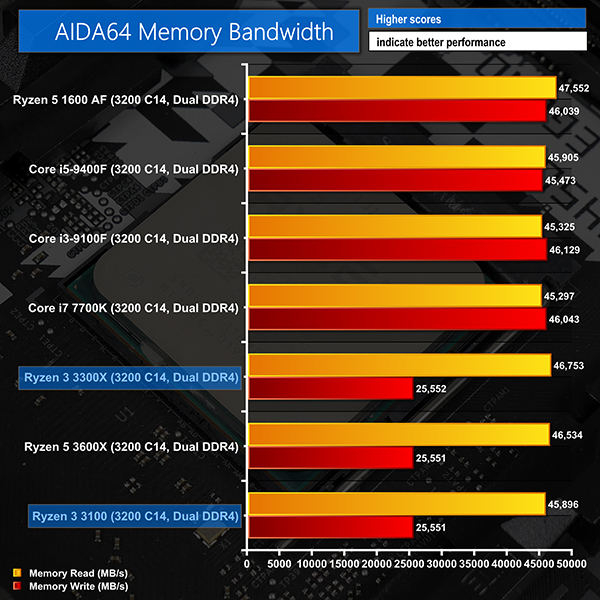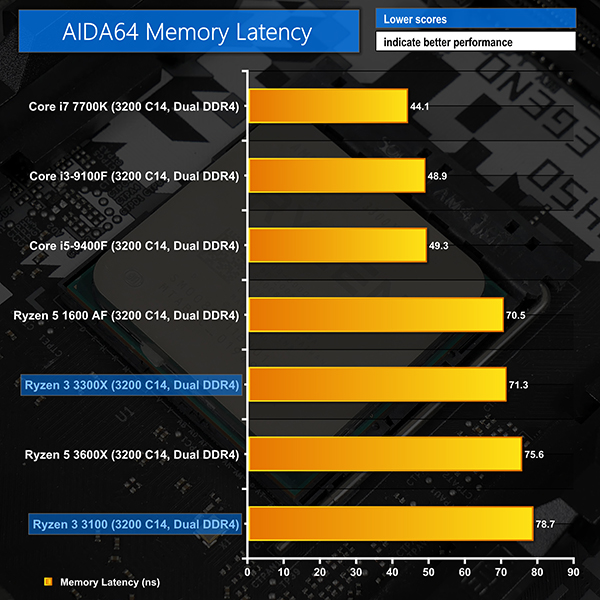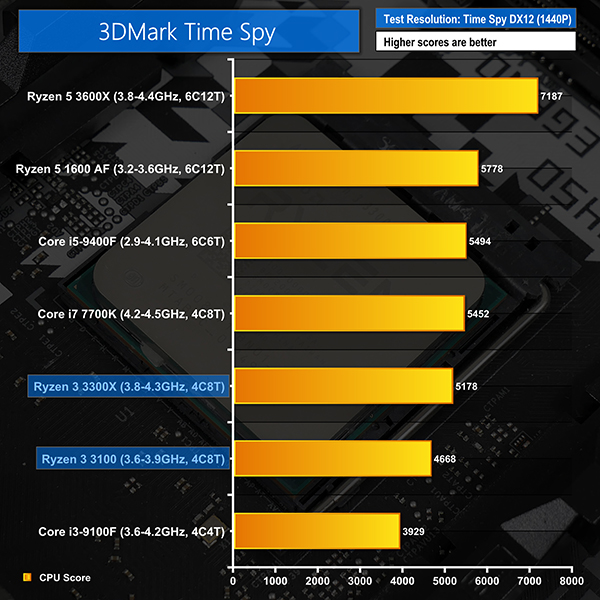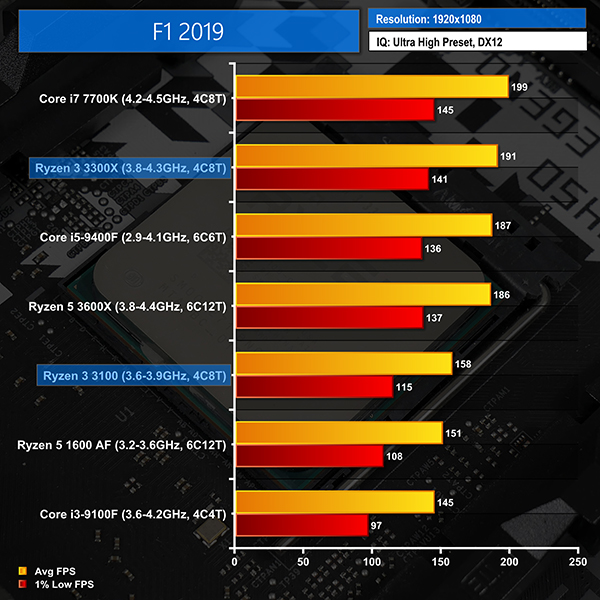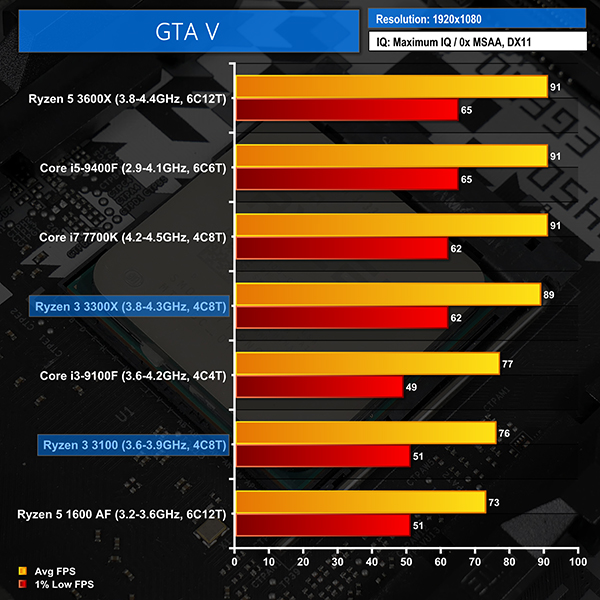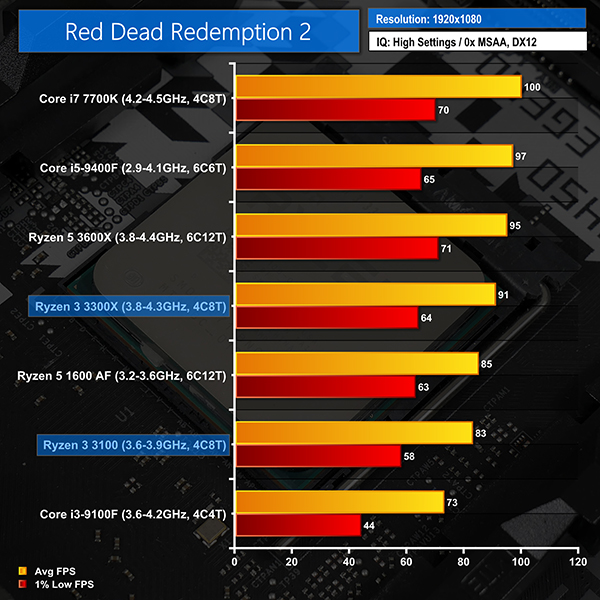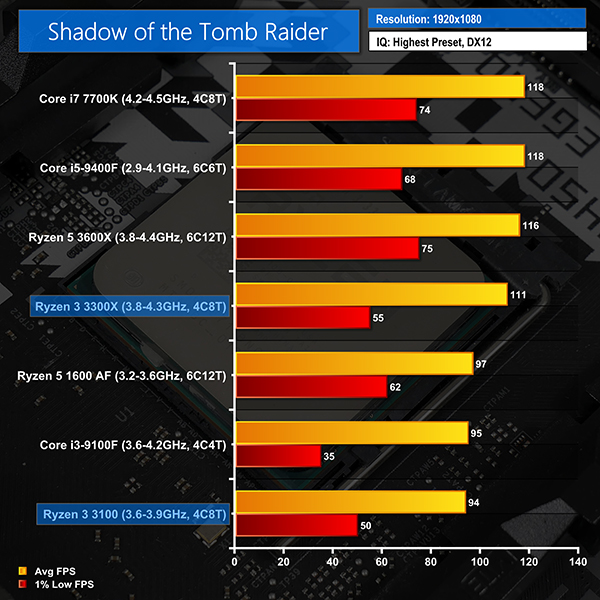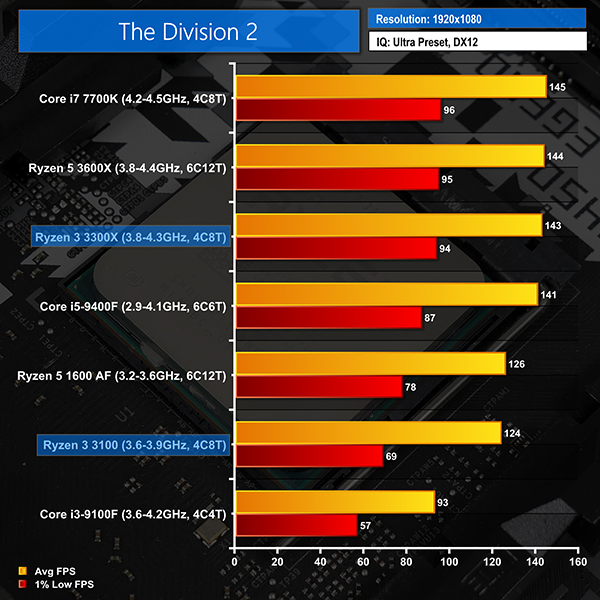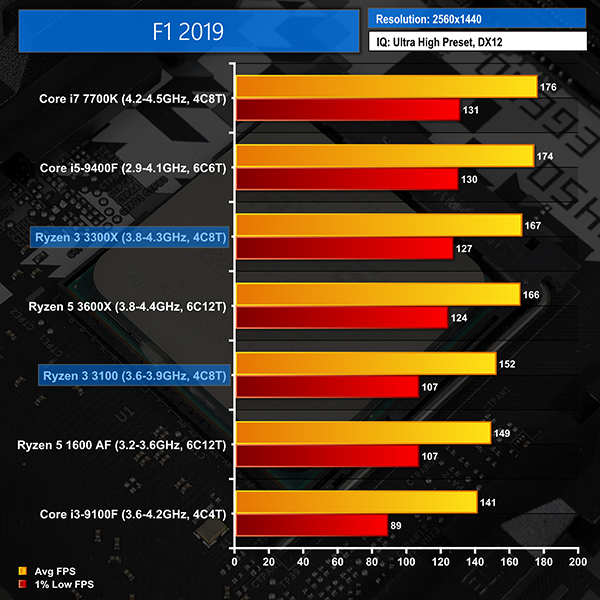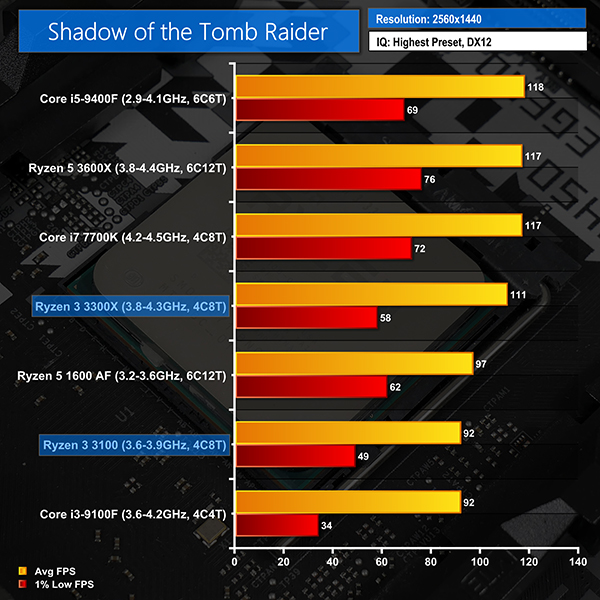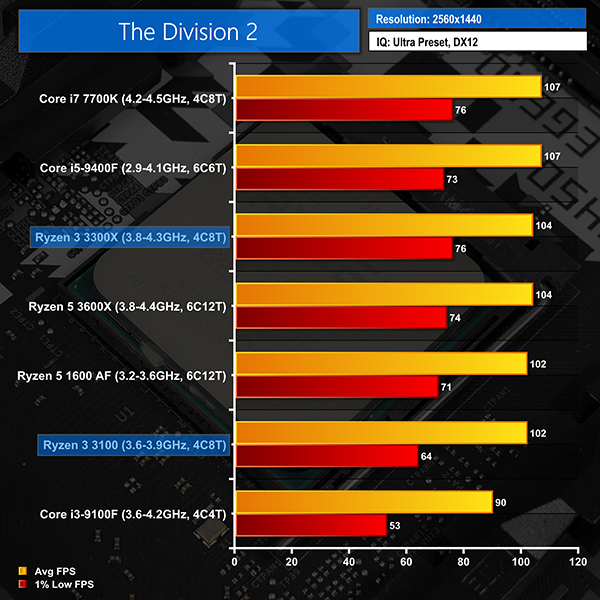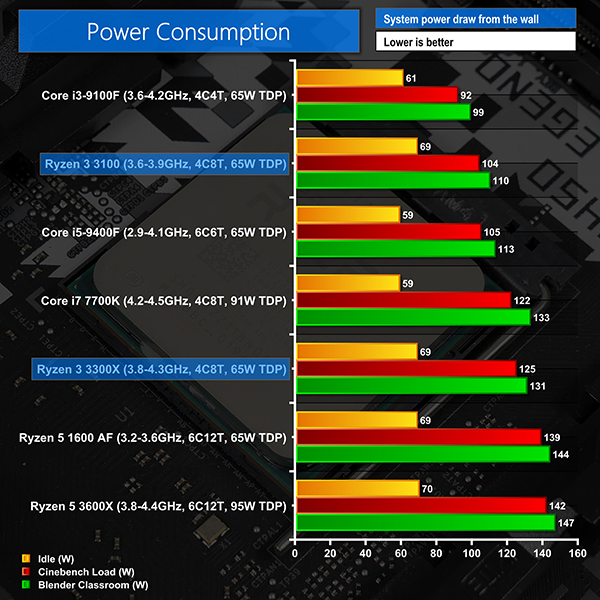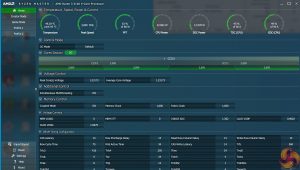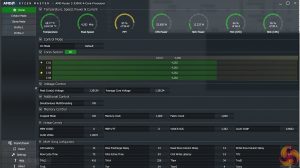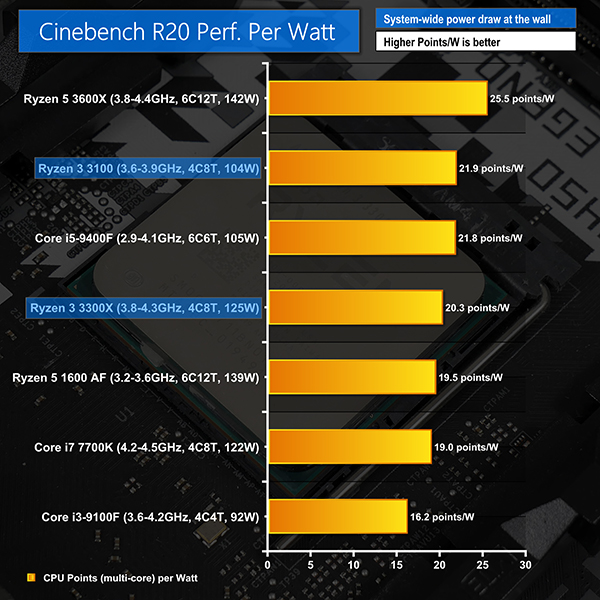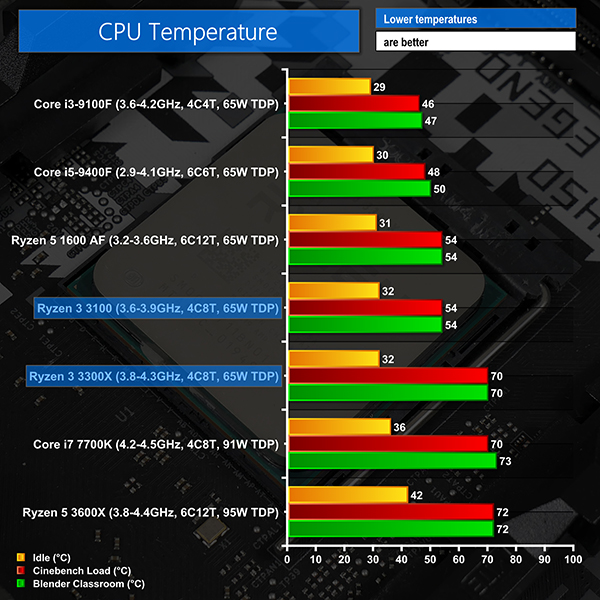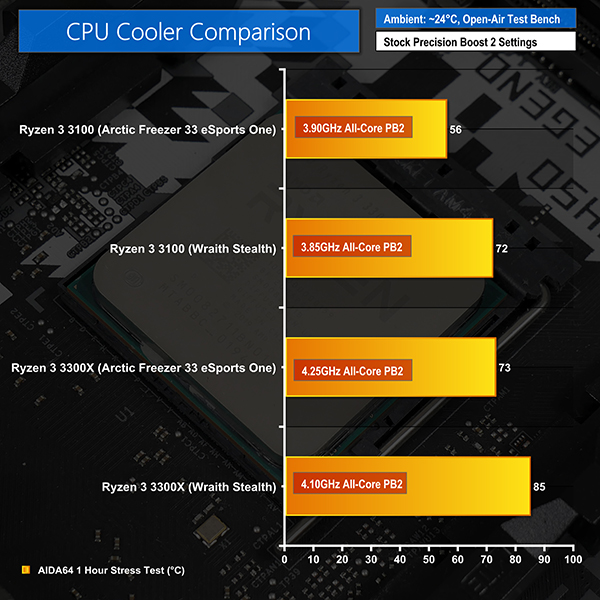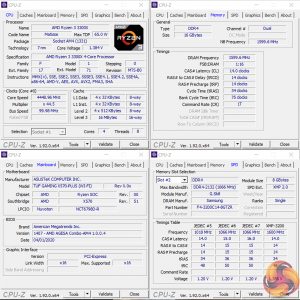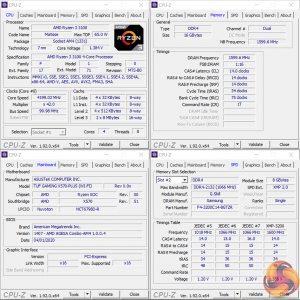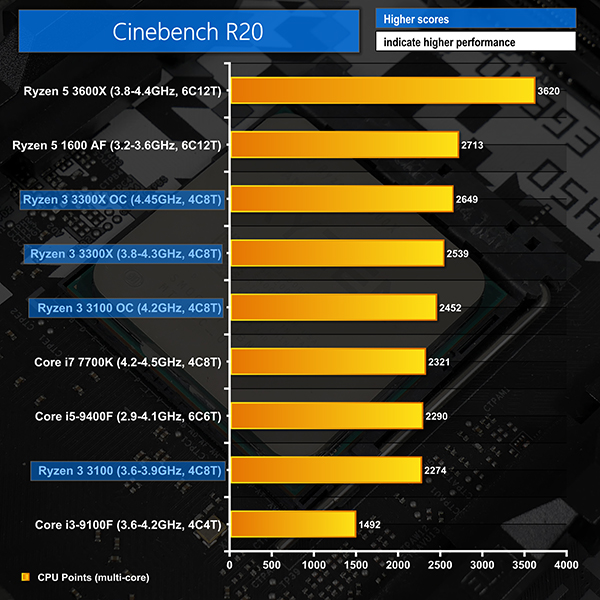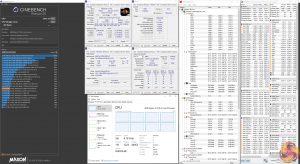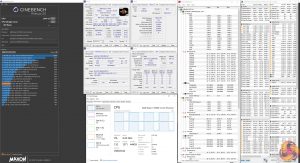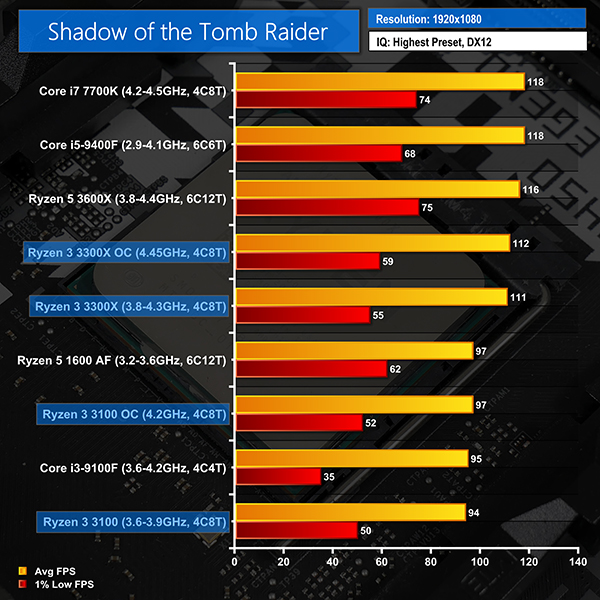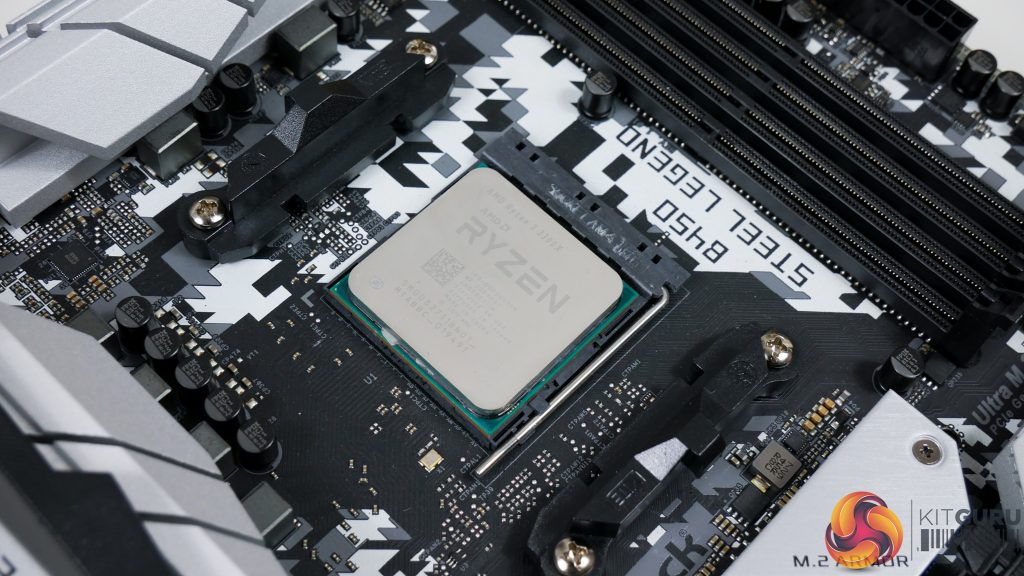The sub-£150 market segment has been a clear void in AMD's Zen 2 product stack. That changes today with the launch of four-core, eight-thread Zen 2-based Ryzen 3 chips. Coming in at £95 for the Ryzen 3 3100 and £115 for the 3300X, AMD is taking aim at Intel's current Core i3 and lower-end Core i5 offerings whilst also sending a warning shot across the bow of Intel's Comet Lake-S launch vehicle.
The Ryzen 3 3100 and 3300X are Zen 2 -based four core, eight thread processors built on TSMC's 7nm process technology. Entering the market at £95 in the UK, the Ryzen 3 3100 clocks in at 3.6GHz base and up to 3.9GHz boost frequency. The £115 Ryzen 3 3300X ups its base speed to 3.8GHz and offers a strong maximum boost frequency of 4.3GHz.
There is more to the differences between the parts than simply frequency and naming, though; Ryzen 3 3300X is a single-CCX design whereas the 3100 uses two CCXs. Given the pricing, AMD is clearly gunning for Intel's current 9th Gen Core i3 and the lower-end Core i5 options.
AMD deploys a 65W TDP on both of these wallet-friendly CPUs. This allows them to pull up to 88W of package power under normal operation. You can also turn down the TDP to 45W using Eco Mode on compatible motherboards. Bundled cooling comes in the form of AMD's most entry-level option; the short Wraith Stealth heatsink and 2000 RPM fan unit.
And if you fancy playing about with overclocking, the unlocked core ratio multiplier found on all other Ryzen 3000 desktop processors is retained. Of course, a bump up in the cooling hardware is certainly a reasonable recommendation if you're aiming to maintain clock speeds beyond around 4.1GHz or so.
One clear area of differentiation is the Ryzen 3 3300X and its single-CCX design. The $120 chip gets a full Zen 2 CCX in its single CCD. This Core Complex serves up the full 16MB stack of L3 cache and that is likely to be a benefit for games.
By comparison, the Ryzen 3 3100 uses two crippled dual-core CCXs that communicate within the single core chiplet. The key difference is that 8MB of L3 cache is shared across the CCXs thus translating into a latency penalty when more than 8MB of L3 cache is accessed.
It will be interesting to see if this unique Ryzen 3 3300X 7nm, Zen 2-based quad-core is able to muster up noteworthy gaming performance thanks to the elimination of inter-CCX latency penalties.
As is obvious, these are both AM4 chips. You get 16+4+4 lanes of PCIe Gen 4 capability with a compatible motherboard. Dual-channel DDR4 memory is supported and we continue to recommend 3600MHz modules if affordable, or 3200MHz with decent timings as a sensible alternative.
The AM4 platform makes these chips compatible with current X570 and B450 motherboards with a BIOS update, if required. The obvious partner is a budget B450 offering, of which the market provides plenty of options. Or, if you're happy to wait a few weeks, AMD's new B550 chipset will be launching and the motherboard partners will have a raft of new PCIe Gen 4-equipped options flooding the market.
Intel's competition to the Ryzen 3 3100 and 3300X does not really exist at the price point. The 4C4T Core i3-9100F is cheaper at £70 and the 6C6T Core i5-9400F is more expensive at £140. The options in between make little sense from a value perspective for buyers with a dedicated GPU.
The toughest competitor, therefore, is clearly AMD's own Ryzen 5 1600 AF. This 12nm-fabbed Zen+ processor features six cores and twelve threads and, despite its confusing naming, is basically a slightly slower version of the Ryzen 5 2600. Priced at around £99 in the UK when we bought our unit last week, the 1600 AF will be a tough contender. Thankfully for the new Ryzen 3 chips, however, the older Zen+ hexacore is getting increasingly difficult to find in stock or at its reasonable sub-£100 price.
Let's see how the new Ryzen 3 processors compare against the Ryzen 5 1600 AF, their higher-end Ryzen 5 3600X sibling, Intel's Core i3-9100F, and the Core i5-9400F. We also throw in comparison against the venerable and incredibly popular Core i7-7700K quad core for good measure, of course.
We will be outlining the AMD Ryzen 3 3100 and 3300X CPUs' performance while using the ASUS TUF Gaming X570-Plus Wi-Fi motherboard. A 16GB (2x8GB) kit of 3200MHz CL14 DDR4 memory serves our test system.
Today's comparison processors come in the form of:
- Coffee Lake Refresh Core i3-9100F (4C4T) and Core i5-9400F (6C6T).
- Kaby Lake Core i7-7700K (4C8T).
- Matisse ‘Zen 2' Ryzen 5 3600X (6C12T).
- Pinnacle Ridge ‘Zen+' Ryzen 5 1600 AF (6C12T).
Each processor is tested at its default out-of-the-box settings. For the Intel CPUs, forced turbo is disabled where possible and the chips therefore abide by the designated turbo bins, albeit with unlimited turbo duration when set by the motherboard. All-core load frequencies for the tested chips are as follows:
- Core i7-7700K = 4.5GHz.
- Core i3-9100F = 4.0GHz.
- Core i5-9400F = 3.9GHz.
- Ryzen 5 1600 AF = 3.6GHz.
- Ryzen 5 3600X = 4.05-4.1GHz.
- Ryzen 3 3100 = 3.9GHz.
- Ryzen 3 3300X = 4.2-4.3GHz.
CPU Test System Common Components:
- Graphics Card: Gigabyte Aorus RTX 2080 Ti XTREME (custom fan curve to minimise thermal throttling).
- Memory: 16GB (2x8GB) G.Skill 3200MHz 14-14-14-34 DDR4 @ 1.35V.
- CPU Cooler: Arctic Freezer 33 eSports One.
- Games SSD: Aorus 2TB PCIe Gen 4 M.2 SSD.
- Power Supply: Seasonic Prime TX-1000.
- Operating System: Windows 10 Pro 64-bit.
LGA 1151 Rev. 2 System (Core i3-9100F, Core i5-9400F):
- Core i3-9100F CPU: Intel Core i3-9100F ‘Coffee Lake Refresh' 4 cores, 4 threads.
- Core i5-9400F CPU: Intel Core i5-9400F ‘Coffee Lake Refresh' 6 cores, 6 threads.
- Motherboard: Gigabyte Z390 Aorus XTREME (LGA 1151 rev. 2, Z390).
- System Drive: Plextor M9Pe 512GB.
AM4 System (Ryzen 3 3100, Ryzen 3 3300X, Ryzen 5 1600 AF, Ryzen 5 3600X):
- Ryzen 3 3100 CPU: AMD Ryzen 3 3100 ‘Matisse' 4 cores, 8 threads.
- Ryzen 3 3300X CPU: AMD Ryzen 3 3300X ‘Matisse' 4 cores, 8 threads.
- Ryzen 5 1600 AF CPU: AMD Ryzen 5 1600 AF ‘Pinnacle Ridge' 6 cores, 12 threads.
- Ryzen 5 3600X CPU: AMD Ryzen 5 3600X ‘Matisse' 6 cores, 12 threads.
- Motherboard: ASUS TUF Gaming X570-Plus Wi-Fi (AM4, X570, AMD AGESA Combo-AM4 1.0.0.4).
- System Drive: WD Black SN750 500GB.
LGA 1151 System (Core i7-7700K):
- Core i7-7700K CPU: Intel Core i7-7700K ‘Kaby Lake' 4 cores, 8 threads.
- Motherboard: Gigabyte Z270X-Gaming 7 (LGA 1151, Z270).
- System Drive: Corsair Neutron XTi 480GB.
Tests:
Productivity-related:
- Cinebench R20 – All-core & single-core CPU benchmark (CPU)
- Blender 2.82a – All-core rendering of the BMW benchmark (CPU)
- HandBrake x264 – Convert 1440p60 H264 video to 1080p60 H264 using the YouTube HQ 1080p60 preset (CPU)
- 7-Zip – Built-in 7-Zip benchmark test (CPU & Memory)
- SiSoft Sandra – Memory bandwidth and Cache & Memory Latency Test (Memory)
- AIDA64 – Memory bandwidth & memory latency (Memory)
Gaming-related:
- 3DMark Time Spy – Time Spy (DX12) test (Gaming)
- F1 2019 – 1920 x 1080, 2560 x 1440, Ultra High quality preset, DX12 (Gaming)
- Grand Theft Auto V – 1920 x 1080, Maximum quality settings, Maximum Advanced Graphics, DX11 (Gaming)
- Red Dead Redemption 2 – 1920 x 1080, High settings manually applied, DX12 (Gaming)
- Shadow of the Tomb Raider – 1920 x 1080, 2560 x 1440, Highest quality preset, no AA, DX12 version (Gaming)
- The Division 2 – 1920 x 1080, 2560 x 1440, Ultra quality preset, no AA, DX12 version (Gaming)
Cinebench R20
Cinebench R20 gives us a first look at the four-core, eight-thread Ryzen 3 Zen 2 chips. Multi-core performance is clearly a strength with AMD’s new value processors; the 3100 keeps pace with the more expensive Core i5-9400F hexacore and absolutely destroys the £70 Core i3-9100F. Meanwhile, the 3300X sees performance that is 9% quicker than the ageing but popular Core i7-7700K. If you want higher scores at this budget segment of the market, the £100 Ryzen 5 1600 AF proves strong despite its older Zen+ architecture. A good start for the Ryzen 3 chips, we’d say.
Clock speed wise, the Ryzen 3 3300X held stable at around 4.2-4.3GHz throughout our Cinebench runs with the Arctic cooler. The 3100 was happy at its maximum boost value of 3.9GHz.
Thanks to its lofty 4.3GHz boost frequency, the 3300X hits joint-top position with just over 500 points in 1T testing. Around a 10% drop-off is observed when switching to the 3.9GHz Ryzen 3 3100. But that $99 part still beats out the similarly priced Ryzen 5 1600 AF, as well as the Intel competitors that run at comparable clock speeds.
Blender BMW Benchmark
Ryzen 3 3300X in particular puts in another stellar display when looking at Blender’s BMW test. It will take a six-core Ryzen 5 1600 AF on the older Zen+ architecture to outperform the 3300X at this price point; Intel’s current competitors are significantly slower and even the trusty old 7700K cannot keep pace at stock clocks.
We see the Ryzen 3 3100 offering competitive performance versus the £140 Core i5-9400F but not quite matching that six-core part. AMD’s new value option does, however, comfortably outperform the cheaper Core i3-9100F. Clearly, there is a performance void that Intel needs to fill with Comet Lake-S around the £100-120 price point.
7-Zip
7-Zip compression has long been a strength for AMD’s Zen 2 architecture. Here, we see the Ryzen 3 3300X match the six-core Ryzen 5 1600 AF for the first time in our multi-threaded testing.
Unsurprisingly, the slower-clocked Ryzen 3 3100 drops off compared to its bigger brother. With that said, the £95 chip still manages to outshine the costlier Core i5-9400F and Core i7-7700K parts, albeit by a slim margin.
Decompression sees the 1600 AF put its extra threads to use to regain an 18% advantage versus the 3300X. Nevertheless, the budget Zen 2 chips offer up a performance increase of 9-19% over the venerable Core i7-7700K. That performance uptick for the cheap AMD parts increases to 15-25% versus the more expensive Core i5-9400F.
Handbrake
Ryzen 3 3300X outperforms the £25 more costly Core i5-9400F by 5% in our Handbrake x264 test. With that said, the £99 Ryzen 5 1600 AF overcomes its older Zen+ architecture with the brute force of a dozen processing threads to beat AMD’s new chip by 14%.
Looking at the cost-effective Ryzen 3 3100, we see the quad-core Zen 2 part roughly matching Intel’s Core i7-7700K mainstream flagship from the Kaby Lake era. That’s quite the change of tides in a little over three years.
Sandra Memory Bandwidth
AIDA64 Memory Performance
Memory bandwidth falls in line with what we see from other Zen 2-based chips. As these are single-CCD processors, you get the same half-speed write bandwidth that we see on Zen 2 Ryzen 3000 chips below the twelve-core 3900X.
Memory latency also positions roughly where we would expect it to be. The Ryzen 3 3300X looks to have a little less memory latency and this could potentially be attributed to its single-CCX design.
Speaking of single-CCX design, we see the Ryzen 3 3300X’s Inter-CCX latency as zero as it only has the one CCX. In a lower-is-better scenario, this beats the 3100 and 3600X’s 81 ns and the 1600 AF’s 125 ns. The Ryzen 5 1600 AF’s Inner-CCX latency is also worse at 45 ns versus 33 to 37 ns for the Zen 2 parts, clock speed dependant.
SiSoft Sandra’s Cache and Memory Latency test also highlights latency improvements for the Zen 2 chips versus the 1600 AF that is otherwise proving a tough contender.
3DMark
F1 2019
We run the game quality set to Ultra High.
Starting our gaming comparisons with F1 2019, we see the Ryzen 3 3300X putting in a superb showing thanks to its Zen 2 architecture and lofty clock speeds that hold stable thanks to relatively light cooling requirements.
Intel’s competing Core i5-9400F is no slouch in this test; it manages to outperform the 3.9GHz Ryzen 3 3100 and is very close to the speedier 3300X. It is also more expensive than both, though, and therefore steals money from a graphics card purchase.
Ryzen 5 1600 AF still does well in this test, but the newer Zen 2 chips are tangibly faster if you are a high refresh rate 1080P gamer.
Grand Theft Auto V
We run the game using generally Maximum quality settings (including Advanced Graphics).
Old but still immensely popular… and tough to get running at high frame rates, Grand Theft Auto V is next up. The Ryzen 3 3300X does well in this older DX11 title that clearly favours a mix of threads and, more importantly, frequency. GTA V also favours the Intel architecture, which is not all that surprising given its age.
As such, we see the Core i5-9400F outperforming the cheaper Ryzen 3 3300X, albeit by a negligible margin. We also see the lower-cost Core i3-9100F roughly matching the stock-clocked Ryzen 3 3100. The key difference between the four-core, four-thread Core i3 and AMD’s eight-thread competitor is that the latter has some amount of CPU headroom still available. The Core i3, by comparison, is glued to 100% usage and therefore had limited ability to deal with background operations.
There are positives to be taken from GTA V; the new £115 Ryzen 3 3300X is about as quick as a gaming elite from generations gone by – the 4.5GHz Core i7-7700K. The Zen+ Ryzen 5 1600 AF is clearly a less than ideal choice in this title – a statement that holds true for the £95 Ryzen 3 3100.
Red Dead Redemption 2
We run the game with image settings manually set to High and the DirectX 12 mode enabled.
Given that GTA V and Red Dead Redemption 2 are both Rockstar titles, it comes as little surprise that a similar performance hierarchy is observed. The preference for Intel Skylake-based architecture is evident again.
Ryzen 3 3300X does pretty well to get within 10% of the high refresh rate performance offered by the more expensive 9400F and the resilient 7700K. This time around, Ryzen 5 1600 AF and its dozen Zen+ threads prove slightly quicker than the Ryzen 3 3100, which in itself is vastly superior to the stuttering four-core, four-thread Core i3-9100F.
Overall, Ryzen 3 3300X looks to be a good choice for higher-than-60-FPS gaming in Red Dead Redemption 2, especially given its cost decrease versus the Core i5-9400F. Not to be ignored though, the slightly cheaper Ryzen 5 1600 AF puts up a solid fight and manages to narrowly outperform the similarly priced Ryzen 3 3100.
Shadow of the Tomb Raider
We use the DirectX 12 mode, anti-aliasing disabled, and the Highest quality preset.
Ryzen 3 3300X hangs reasonably close to the top position in Shadow of the Tomb Raider. With that said, its reduction in frequency or cores versus the parts sitting above it do force a quite significant drop-off in 1% low FPS values.
The Ryzen 5 1600 AF is slower in terms of average FPS but does offer higher 1% low numbers, which implies solid gaming consistency on that older six-core alternative.
Ryzen 3 3100 actually sits at the bottom of the chart when ordered by average FPS. But this is highly misleading as the Core i3-9100F is a stuttering mess, as shown by its 1% low value, and is an unpleasant gaming experience at these settings. And that doesn’t even reference the significant level loading times and texture pop-ins for Intel’s cheap four-thread chip that we did not observe on any other processors.
In this title, the Ryzen 5 1600 AF is hard to beat from a value perspective, but the extra £15 for the new Ryzen 3 3300X will net higher average FPS numbers if your monitor goes past 100 Hz.
The Division 2
We run the game with quality set to Ultra, VSync disabled, and DX12 mode.
Ryzen 3 3300X is about as fast as it gets in The Division 2. Both the average and 1% low FPS numbers are excellent even for high refresh rate 1080P gamers. The more expensive Core i5-9400F is a little slower, albeit by a small margin.
Switching focus to the Ryzen 3 3100, we see it battling closely with the £99 Ryzen 5 1600 AF yet again. Average FPS numbers are comparable between the two, but the twelve-thread Zen+ chip has the advantage in 1% low performance.
We supplement the 1080p gaming results with three games tested at 2560×1440 resolution.
F1 2019
The Core i5-9400F is less impacted by the resolution increase to 1440P in F1 2019. That allows its average FPS performance to leapfrog the Ryzen 3 3300X into second position. Nevertheless, nobody will complain about 167 average FPS numbers and comparable performance to the Ryzen 5 3600X from a £115 quad-core.
Higher performance is still achieved by the Ryzen 3 3100 versus the 1600 AF, but this time the margin is tight and realistically negligible in real world gameplay.
Shadow of the Tomb Raider
Shadow of the Tomb Raider performance barely changes from 1080P to 1440P such is the load on the GPU and CPUs. Ryzen 3 3300X still hangs close to the 9400F, 7700K, and 3600X whilst comfortably outperforming the Ryzen 5 1600 AF.
Speaking of the 1600 AF, AMD’s Zen+ value king retains its average and 1% low FPS upper hand versus the equally priced Ryzen 3 3100. Intel’s Core i3-9100F continues to be a stuttering mess at this level of demand.
The Division 2
With the higher GPU load of 1440P applied, we see performance grouping just below the 110 average FPS level in The Division 2. There is little room to identify performance differences between the competing CPUs at these settings, but the Ryzen 3 3100 does struggle to keep up with the 1600 AF in terms of 1% low FPS values.
We leave the system to idle on the Windows 10 desktop for 10 minutes before taking a power draw reading. For CPU load results, we read the power draw while producing five minutes' worth of runs of the Cinebench R20 multi-threaded test. We also run the Blender Classroom rendering stress test for five minutes.
The power consumption of our entire test system (at the wall) is shown in the chart. The same test parameters were used for temperature readings.
Power Consumption
Power draw readings are accurate to around +/-5W under heavy load due to instantaneous fluctuations in the value. We use a Titanium-rated Seasonic 1000W Prime PSU.
CPU compute performance on the Ryzen 3 3100 was overall slightly better than that of the Core i5-9400F, even though both chips draw roughly the same power.
Looking at the Ryzen 3 3300X, we see similar power numbers to the 4.5GHz Core i7-7700K but AMD’s Zen 2 quad-core is notably faster in our CPU compute tasks.
As far as power efficiency goes, this is a clear area where the new 7nm Ryzen 3 chips manage to beat the Ryzen 5 1600 AF and its 12nm fabrication node.
Worth noting is that neither Ryzen 3 processor used its full 88W CPU package power allowance, as dictated by the 65W TDP. That brings about the option for running the chips in a 45W TDP Eco Mode configuration with relatively little drop off in performance for the Ryzen 3 3100 in particular.
Cinebench nT performance per Watt comparisons clearly favour higher multi-threading so it is impressive to see the quad-core Ryzen 3 parts doing particularly well. Ryzen 3 3100 offers comparable performance efficiency to Intel’s Core i5-9400F but the higher-clocked 3300X leverages more energy.
Temperatures
Temperature recordings were taken using the Arctic Freezer 33 eSports One CPU cooler at full fan speed. Ambient temperatures were around 24-25°C.
As proven by our use of a bargain basement £20 air cooler, it does not take a lot to cool any of these reasonable core count processors at stock clock speeds.
Ryzen 3 3100 runs significantly cooler thanks to its roughly 400MHz clock speed deficit versus the 3300X. We have observed time and time again that Zen 2 starts to get increasingly hot when pushed beyond 4GHz clock speed.
AMD’s four-core, eight-thread part is just as easy to cool as the 9th Gen Intel processors above and below its price point. The same comparison holds true for the Ryzen 5 1600 AF and its mid-3GHz operating speed.
While we used a budget aftermarket CPU cooler to extract maximum performance from the Ryzen processors and to make temperatures comparable across AMD and Intel platforms, we were keen to see how the boxed Wraith Stealth cooler would perform.
At 100% fan speed on our open-air test bench, the Wraith Stealth only dropped around 50MHz off the Precision Boost 2 all-core frequency for the Ryzen 3 3100. That came with the penalty of a 16°C increase in operating temperature.
Switch from our Arctic Freezer 33 eSports One to the 3300X’s included Wraith Stealth heatsink and you can expect to lose around 150MHz on the Precision Boost 2 algorithm when running extended all-core loads. The temperature also increased by 12°C to a rather toasty 85°C.
Put simply, the included Wraith Stealth heatsink is perfectly adequate. However, when aiming to maintain frequencies beyond 4.1GHz under all-core loading, even a budget £20 tower cooler proves a worthy upgrade.
AMD Ryzen 3 3300X Manual Overclocking Frequency:
We managed to push our 3300X sample to 4.45GHz using 1.4V in the ASUS UEFI. This was quick and easy and proved stable even with our budget Arctic CPU cooler.
As the 3300X is already clocked high out of the box, our overclock only added around 5W onto the package power draw and the actual load voltage barely changed.
AMD Ryzen 3 3100 Manual Overclocking Frequency:
The 3100 pushed to 4.2GHz on all cores using the same 1.4V in the ASUS UEFI. CPU package power this time increased to around 75W under Cinebench load, so cooling the overclocked chip is still an easy task.
I guess there’s a reasonable argument that the full four-core CCXs of the 3300X are higher quality silicon than the severely crippled two-core CCXs forming the 3100.
A modest but worthwhile performance gain was registered for the overclocked Ryzen 3 3300X. The 3100’s gain was slightly more noticeable as it represented a larger percentage increase from its stock frequency.
Interestingly, our overclocked testing highlights the importance of Ryzen 3 3300X’s CCX topology. The 4.2GHz overclocked Ryzen 3 3100 is just shy of the 3300X’s 4.3GHz stock-clocked frequency. However, the cheaper dual-CCX part is noticeably slower in Shadow of the Tomb Raider performance. The 16MB of local L3 cache and no inter-CCX latency are clearly a benefit for the Ryzen 3 3300X in certain scenarios.
AMD’s four-core, eight-thread Ryzen 3 3100 and 3300X are clearly the final pieces to AMD’s Zen 2-based Ryzen 3000 puzzle. This sub-£120 area of the market is one in which Intel’s current generation line-up competed against AMD’s older architecture prior to today’s launch. Zen 2 is now affordable to budget system builders who simply want a basic yet proficient processor with modern architecture, reasonable frequencies, and the inherent benefits that the 7nm process node provides. Ryzen 3 3000 delivers on those fronts.
Strong gaming performance and productivity numbers that clearly punch above their weight are the overriding takeaways from the Ryzen 3 parts. The 3300X in particular looks to be a strong gaming option in this market segment thanks to its Zen 2 architecture, high out-of-the-box frequencies, and single CCX design.
Couple in the superb AM4 platform with cost effective motherboards, high-speed memory support, and unlocked multipliers across the board and the Ryzen 3 3100 and 3300X are clearly superior to Intel’s 9th Gen price competitors.
However, it is clear that the Zen+ Ryzen 5 1600 AF with its twelve processing threads is a value champion that remains impossible to beat at around £90-100. Even the newer, budget friendly Ryzen 3 chips with their £95-115 price tags and Zen 2 architecture cannot match the multi-threadedness of the 1600 AF. Of course, frequency advantages brought about by TSMC’s 7nm technology help the Ryzen 3 3300X and 3100 comfortably outperform the 1600 AF in lightly threaded tasks. Plus, the Zen 2 architecture is more efficient in other areas such as AVX2 performance.
And competing against the 1600 AF in gaming is a tough task for the new Zen 2 offerings. Ryzen 3 3300X is able to comfortably outperform the 1600 AF most of the time, thanks in large to its high out-of-the-box frequency coupled with the excellent Zen 2 architecture. The equally priced Ryzen 3 3100, however, has a far tougher time fighting against the sub-£100 Zen+ six-core in games.
Add the approaching launch of Intel’s rumoured four-core, eight-thread Comet Lake-S Core i3 processors and the budget CPU segment of the market is getting highly competitive all of a sudden. According to Intel's 1KU pricing, those Intel chips should price roughly around the Ryzen 3 3300X level. It will be interesting to see Zen 2 versus Comet Lake-S fight it out on a basis with core, price, and frequency parity. Of course, the AM4 platform and upcoming B550 chipset motherboards could well be the deal-sealer in that battle, but we will have to wait and see.
For now, AMD’s Zen 2-based Ryzen 3 chips are welcomed additions to the budget segment of the market. They are clearly superior options to Intel’s current 9th Gen line-up at the sub-£150 mark, but the upcoming Comet Lake-S CPUs will likely bring an interesting fight to the table. AMD’s own Zen+ Ryzen 5 1600 AF also remains a particularly tough competitor, but I would personally be happy to pay the extra £15-20 for the Ryzen 3 3300X’s improved gaming performance and newer Zen 2 architecture.

The Ryzen 3 3100 will sell for £94.99 MSRP. The Ryzen 3 3300X is £114.99 MSRP. Availability will be during May on e-tailers such as Overclockers UK.
Discuss on our Facebook page HERE.
Pros:
- Good gaming performance, especially from the 3300X.
- Strong compute performance compared to 9th Gen Intel competitors.
- Decent out of the box frequencies for the market segment.
- Solid overclocking headroom and very few cooling concerns.
- Bundled Wraith Stealth cooler does well on the 3100.
- Excellent capabilities from the AM4 platform – PCIe Gen 4, high-speed DDR4 support, affordable motherboards.
- Strong and clear upgrade paths thanks to the AM4 platform.
Cons:
- Ryzen 5 1600 AF is a tough option to compete against at £100 (if you can find availability).
- Ryzen 3 3100 sees a gaming performance drop-off due to its CCX topology.
- Wraith Stealth cooler not great for the highly clocked 3300X.
KitGuru says: AMD's Ryzen 3 3100 and 3300X bring strong performance Zen 2 quad-cores to the sub-£120 market segment. Gaming frame rates are strong, especially on the 3300X, and compute performance punches well above the levels set by Intel competitors.
AMD Ryzen 3 3100:
AMD Ryzen 3 3300X:
 KitGuru KitGuru.net – Tech News | Hardware News | Hardware Reviews | IOS | Mobile | Gaming | Graphics Cards
KitGuru KitGuru.net – Tech News | Hardware News | Hardware Reviews | IOS | Mobile | Gaming | Graphics Cards


